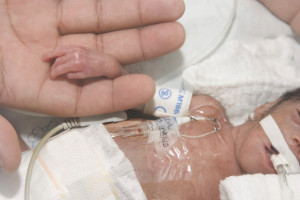 Cognitive function and language development in children with neurodevelopmental delays can be helped dramatically through early detection and targeted interventions during infancy.
Cognitive function and language development in children with neurodevelopmental delays can be helped dramatically through early detection and targeted interventions during infancy.
In a recent study conducted at the Children’s Memorial Hermann Hospital (CMHH) and The University of Texas Medical School at Houston, scientists developed a specialized tool for measuring white matter abnormalities in the brains of high-risk, pre-term infants, which may help predict the effects of such abnormalities on neurodevelopmental outcomes at two years of age.
Thanks to continued advancements in sophisticated diagnostic imaging and analytical software capabilities, researchers today have the ability to zero in on this type of brain tissue and develop predictive models—the key to unlocking critical answers that could pave the way for early therapies to positively impact a young child’s health and quality of life.
The paper details the study of 50 extremely low birth weight (ELBW) infants with no major congenital anomalies, who were cared for in the neonatal intensive care unit of CMHH from 2007 to 2009. The mean gestational age of the infants was 25.5 weeks; their mean birth weight was one pound 10 ounces.
A key part of the study was the creation of a unique brain atlas exclusive to tiny preemies and used to detect and quantify white matter volumes and the related probability of cognitive and language impairment. Of the 50 ELBW infants studied, MRI scans of 19 infants exhibiting varying degrees of white matter abnormalities were randomly chosen for the atlas creation.
The brain atlas used specific shapes, locations and proportions of white matter brain tissue obtained from the MRI scans that were then segmented and volume-rendered using Analyze software. Data were normalized across the controlled population of ELBW infants to create an average anatomy template with corresponding tissue probability maps that correlate to future developmental outcomes.
Thirty-eight of the original 50 ELBW infants were available at two years of age for full analyses using the standardized Bayley Scales of Infant and Toddler Development, Third Edition (BSID III). Tests confirmed a significant correlation between objectively quantified white matter volumes and short-term standardized measures of language and cognitive development.
According to the authors, additional, larger studies looking at school-age outcomes are needed to determine if white matter abnormalities in conjunction with other predictive factors could facilitate early identification of individual infants at high risk for cognitive and language deficits and permit more intensive early intervention therapies. However, results of this research provide an important foundation for future studies that not only may more accurately predict longer-term effects of white matter abnormalities found in tiny preemies well beyond age two, but also may open the doors for greater study of their impact on other functions across varying diseases and populations.
Tags: Brain Studies, Cognitive Development
 AnalyzeDirect
AnalyzeDirect